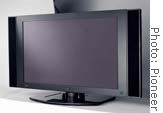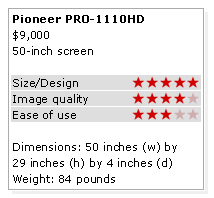NEW YORK (CNN/Money) - Most manufacturers have taken sides in one of two flat-panel camps, plasma or LCD. Image brightness, a warm picture and a wide viewing angle are plasma's main advantages over LCD.
 |
|
| Pioneer PRO-1110HD |
Pioneer is one of the standard-bearers for the plasma side, and its 50-inch Pioneer PRO-1110hd screen makes a nearly irrefutable case for its commitment.
While it costs more than other screens its size (list price is $11,500, but many retailers sell it for under $9,000), the Pioneer has one of the most luminous displays around. That means you'll get a great image no matter what the lighting conditions are in the room.
| Big Screen TVs
|

|
|
|
|
The Pioneer is also beautiful -- a fine set of speakers fit seamlessly with the monitor, finished in an elegant black lacquer. Its picture is dazzling, thanks to a unique feature that lets you adjust every color individually, rather than all at once, like most sets. So cinephiles can watch Technicolor the way Vincente Minnelli intended it.
About plasma screens

These screens are bright enough to watch in a well-lit room. Plasma is an emissive technology (unlike LCD), which means a plasma screen actually lights up, rather than reflects light from another source. Images are softer than LCDs, which makes plasma great for movie watching.
Not all plasmas are high-definition. Lower-priced plasmas (in the $2,500 range), support only the enhanced-definition transmission standard, which is fine for most of today's broadcasts but will not display HDTV. To get the best available picture, look for HDTV-capable sets.
They fade over time. After about 10,000 hours (some makers claim as long as 20,000, or 10 years of six-hour-a-day use), the screen could lose half of its brightness. Flat-screen LCDs aren't prone to such deterioration.

|

